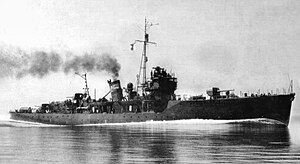Kaibokan
As Kaibōkan (Japanese 海防 艦) (Kai = ocean, Bō = defense, Kan = ship, ocean defense ship) are escort boats of the Imperial Japanese Navy , which were built from 1938 to 1945 in different shipyards in Japan. The Kaibokans were comparable to fleet companions of the Navy and the destroyers escorted by the Allies.
Details of Kaibokans
There were six different Kaibōkan classes. First, the Shimushu class or class A was built. On December 13, 1939, construction began on the Shimushu , the first ship of the Kaibōkan class of the same name. The Shimushu was put into service on June 30, 1940 as the first Kaibōkan. On February 27, 1945, the construction of the ship CD-204 began at the Mitsubishi shipyard , which was launched as the last Kaibōkan on April 14 and was put into service a little later. There were 171 Kaibokans completed by the end of the war. Furthermore, in June 1944, the two captured former Chinese light cruisers Ning Hai as Isojima and Ping Hai as Yasojima were put into service as Kaibōkan. Of the 173 Kaibōkan, only 68 were still operational at the end of the war. The other ships were mostly sunk by attacks by Allied submarines and aircraft.
The Shimushu-class ships were built to act as security ships for convoys , anti-mine vehicles and fishing protection boats. The later classes were only built as security ships for convoys. The main task in the convoy was anti -submarine and anti- aircraft defense .
The ships were armed with three 120-mm guns and classes C and D with two 120-mm guns. There were also up to 20 25-mm anti-aircraft guns and some 80-mm grenade launchers . Up to 120 depth charges were available for up to 12 depth bomb throwers . The ships were equipped with radar , sonar and hydrophone for hunting submarines .
A class ( Shimushu class)
The Shimushu class consisted of only four ships. In addition to the type ship, the Hachijo , Kunashiri and Ishigaki were built. The Ishigaki was launched as the last ship of the class on September 14, 1940. On October 8, 1943, the Ishigaki was the first Kaibōkan to sink a submarine. 55 sailors perished in the sinking of the US American USS S-44 . Only two sailors were saved. On May 31, 1944, the Ishigaki was sunk as the only ship of the Shimushu class. On the Kuril island of Matua , the ship was hit by a torpedo from the American submarine USS Herring in convoy He . 167 Ishigaki sailors perished .
Modified A class ( Etorofu class)
The Etorofu class was the second class of Kaibōkan ships. The Etorofu class was more geared towards submarine combat than the Shimushu class. On 29 January 1943, took place launching of Etorofu . The Wakamiya was the last launch of the class on April 19, 1943 . 14 ships of the class were built. Eight of the ships sank during the war.
B class ( Mikura class)
The Mikura class was the third class of Kaibōkan ships. The Mikura class was even more focused on anti-submarine combat. On July 16, 1943, the Mikura was launched . The last launch of the class was the Yashiro on February 16, 1944. Eight ships of the class were built. Five of the ships, including the Mikura , sank during the war.
Modified B-Class ( Ukuru- Class)
The Ukuru class was the fourth class of Kaibōkan ships. The Ukuru class hull was made in prefabricated sections to reduce construction time. On May 15, 1944, the Ukuru was launched . The last launch of the class was the Ikara on January 22, 1945 . 142 ships were planned and 31 ships of the class were built. Eight of the ships sank during the war and another four ships were damaged in a shipyard when Japan surrendered.
C class
The C-class was the fifth class of Kaibōkan ships. The C-class has been greatly simplified in order to be able to build this class faster. The ships of the C-class and the following D-class were no longer given names, only numbers. On December 29, 1943, the type ship CD-1 was launched . The last launch of the class was the CD-227 on February 10, 1945 . The construction of 300 ships was planned. 56 ships of the class were built. 28 of the ships sank during the war or were no longer operational at the end of the war.
D class
The D-class was the sixth class of Kaibōkan ships. Since Japan no longer had enough diesel, the D-Class ships were modified from January 1945 so that they could use coal as fuel. The type ship CD-2 was launched on December 30, 1943 . The last launch of the class was the CD-204 on April 14, 1945 . 203 ships of the class were planned and 67 ships were built. 26 of the ships sank during the war or were no longer operational at the end of the war.
literature
- Worth, Richard, Fleets of World War II , Da Capo Press (2001), ISBN 0-306-81116-2
- KAIBOKAN! Stories and Battle Histories of the IJN's Escorts
- Kimata Jirō (木 俣 滋 郎). Military history of Japan's coastal defense ships (『日本 海防 艦 戦 史』). Toshu Publishing (図 書 出版社), 1994. p. 299



